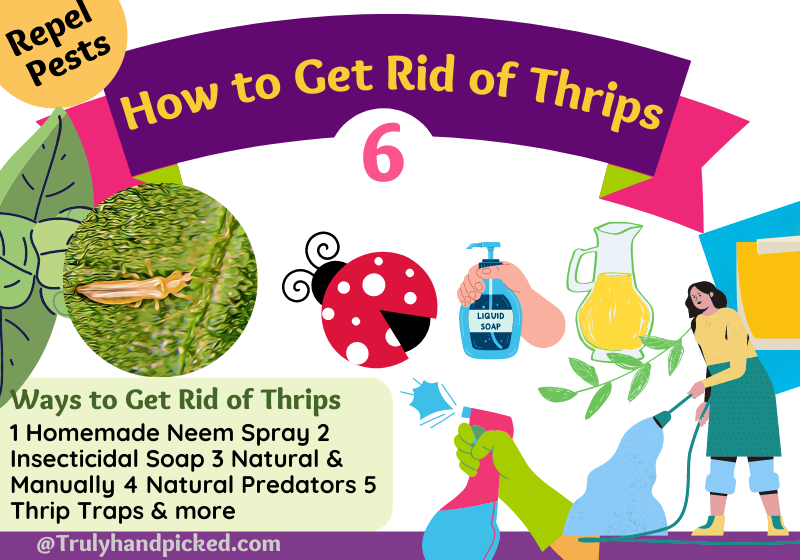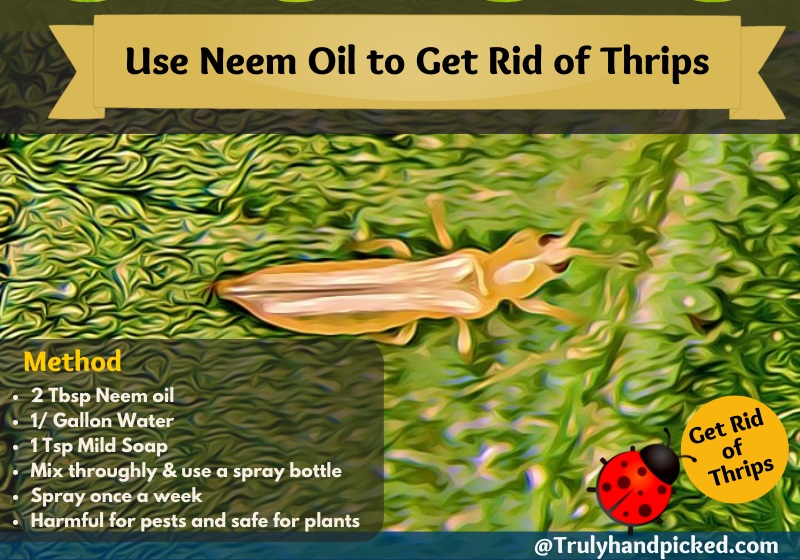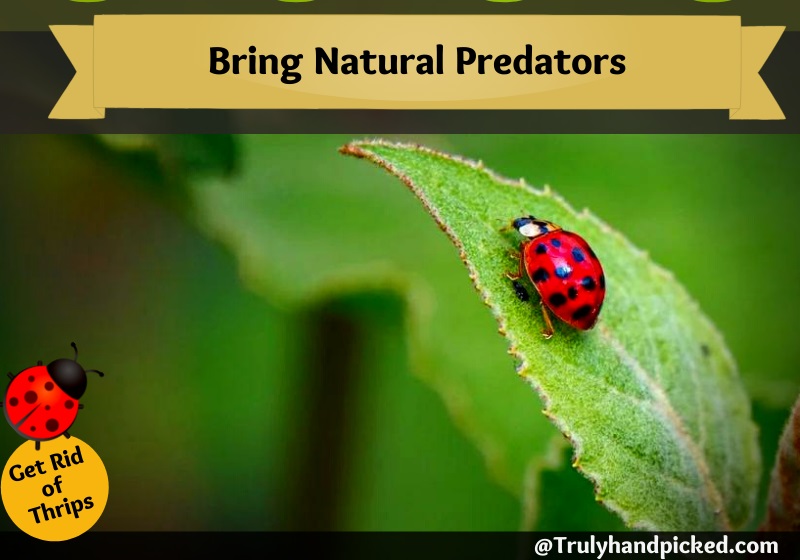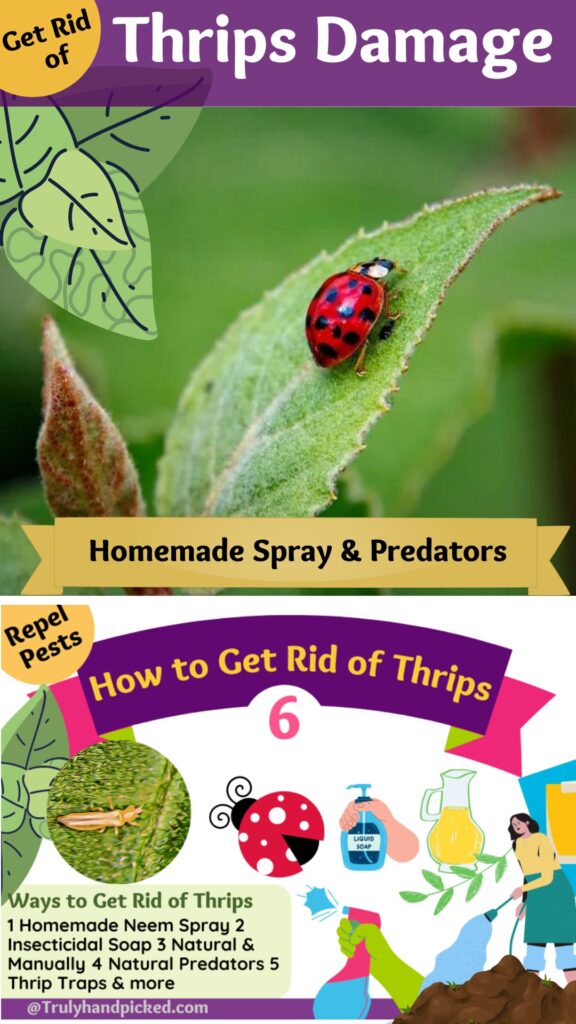Damage: Thrips damage looks like white patches, a large number of slivery spots, and thin line marks on leaves. Also, your plant will have stunted growth, lessened flowers, and fruits or damaged flowers as the thrips suck your plant sap and feed on flowers.
To get rid of thrips make use of effective homemade spray with neem oil, introduce predators like lady beetles, use blue /yellow sticky traps, pressure wash your plants and coat with garlic chilly spray and use insecticidal soap. With these home remedies, the infestation should cease soon and your plant should recover slowly.
Thrips are one common pest that can provide a real nuisance to your garden by destroying your houseplants entirely. Any gardener scares of these tiny greenish-black bugs that feed on each part of a plant starting from seedlings, stems, leaves, and flowers, along with fruits.
So, if you ever find thrips in of your houseplants, try remedy methods as soon as probable, before it abolishes your whole garden single-handedly. Let’s check out these simple yet effective methods to get rid of them completely from your garden without spending much effort.
What are Thrips?
Thrips are tiny bugs that appear on houseplants and feed on the important parts of a garden plant. They used to take a bite on the plants and suck the sap of stems, leaves, buds, blooms, and even crops. They crawl over the plant from bottom to top and infect the plant entirely once they grasp one.
Where Do They Come From?
Thrips always come from outside of your house. So, they can enter your garden only if you bring a new plant from the nursery that is already infected by them, or if you bring any infected veggie or fruit from the market and put it near your houseplant.
Sometimes, thrips can hit your favorite indoor plant if you put it outside of your house in the summer and then, put it back inside with other indoor plants.
What Do Thrips Look Like?
Thrips are extremely tiny bugs. They have a slender body with silvery wings and are extremely hard to see with bare eyes due to their tiny shape.
Thrips only reach 1.25-1.50 inches height in their adulthood. They can grow in a few different shades like yellow, green, dark green, and even black.
How Do I Know My Houseplant Has Thrips?
It is hard to detect thrips in your houseplants at the primary stage, as thrips are extremely tiny and merge with the color of leaves easily. However, once they start feeding on the sap of your plant, you will get a clear indication of having thrips on your plants. Some of the common signs of having thrips on indoor or outdoor plants are as follows-
- Plants will start looking dry and weaker
- The growth of your plant will stunt
- Leaves and flowers of an infected plant will turn brownish-yellow soon
- Young leaves and fruits of the infected plant will get distortion
- Flowers will get spots
- Older leaves will have a silvery layer
- And you will find the existence of tiny insects in flowers and the undersides of the young leaves clearly.
How to Get Rid of Thrips
Homemade Spray for Thrips
Some of the home remedies work exceptionally well to remove thrips from your houseplants. Applying some effective essential oils and organic oils will aid us immensely in this attempt. Some most effective oils you can utilize here are-
- Neem oil
- Mint oil
- Lavender oil
- Rosemary oil
- And marjoram oil
Among them, neem oil works best on cleaning thrips from your indoor as well as outdoor plants efficiently. Let’s learn the using process-
- Take 2 tbsp of neem oil with 1 gallon of warm water in an empty spray bottle along with a few drops of dish soap
- Now, coat the infected plant with this solution after shaking the bottle properly
- Make sure you coat the entire plat including stems and each leaf with this solution
- Try this method consistently for one week to get rid of thrips completely.
Neem oil is also effective against similar leaf damaging pests. Learn more about the difference between aphids and thrips to identify and use homemade sprays to get rid of aphids on plants.
Sprinkle Insecticidal Soap:
Well, some insecticides manufacture with less harmful ingredients and fewer chemical contents. You can try these methods on thrips to remove thrips instantly without harming your garden plants too much. Some of the useful insecticidal options in this regard are-
- Pyrethrin
- Citrus base mild liquid soap
- Green Drago Insect killing soap
- Beta and Bio Eco Friendly Remedy for Insects
- Magic Protector, etc.
Using insecticidal soap, neem, and hydrogen peroxide drench is good to get rid of fungus gnats.
Quick Natural & Manual Ways:
If you don’t want to apply any kind of pest repellent method on your favorite garden plant then, try these natural removing methods for thrips. Such as-
- Rinse your plants and leaves with a hose (a steady stream of clear water at moderate pressure)
- Repeat this process every day until you clean up the whole clan of thrips from your houseplant
- You can use lukewarm water instead of plain water to get a faster result of your method
- Coat your plant or the affected area with capsaicin/garlic chilly spray, as thrips couldn’t stand the spicy taste of this product
- Prune your plant, especially the leaves which are infected by thrips
- Use aluminum foil for mulching as thrips don’t like reflecting materials
- And keep the stem and leaves of your plant moist with often water-sprinkling, as thrips don’t like much humidity.
Also, check for the ways to get rid of plant damaging mealybugs.
Bring Natural Predators:
Bringing natural predators is a good idea either to get rid of thrips from your houseplants. These predators will eat thrips out of your plants entirely and control the infestation of these disgusting bugs instantly. Some of the most efficient predators for thrips are-
- Minute pirate bugs
- Cucumeris
- Lacewings
- Nematode species
- Amblyseius swirskii, etc.
Learn more about ways to attract predators at how to attract ladybugs to your garden.
Set Thrip-Traps:
Setting some sticky inescapable traps for thrips could help you get rid of this damaging pest perfectly. Covering the stem of your plant with tape will prevent them from reaching its food source by making it slippery.
You can also try some ready-made sticky traps around your plants. Yellow or blue sticky straps are easily available in the market. They will easily get caught by such traps as they fly often. Once they get wedged, remove the trap and place a new set until you get rid of their clan entirely.
How to Prevent Thrips:
Thrips are extremely annoying, stubborn, and destructive bugs you can find on a houseplant. It is quite tricky to get rid of thrips, once they grasp your succulent plant fully.
So, it is always better to keep your garden plant away from the reach of thrips, isn’t it? Here are some useful tips in this attempt, which will help you to keep thrips away from your houseplants and prevent them from appearing-
- Take a close look at your houseplants every day
- Verify for the signs of thrips
- Wash the leaves and stems of your favorite plats after every few whiles
- Inspect the backside of the leaves very often as they start their infestation from there
- Always check a new plant vigilantly before bringing it home from any sources
- And check your garden crops attentively before bringing them near any other plants.
FAQ: Know About Thrips
What is the Life Cycle of Thrips?
Thrips go through five stages in their life cycle. These are egg, larval, prepupal, pupal, and then adult. They take 13 to 19 days to complete their life cycle, after hatching from eggs.
Can Thrips Live on Humans and Bite Humans?
Thrips are minute in species, and elongated insects, which always feed on plants and their objects. So, they can’t live on humans, but they can bite humans and cause some minor irritation on human skin.



